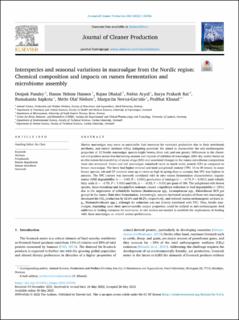| dc.contributor.author | Pandey, Deepak | |
| dc.contributor.author | Hansen, Hanne Helene | |
| dc.contributor.author | Dhakal, Rajan | |
| dc.contributor.author | Aryal, Nabin | |
| dc.contributor.author | Rai, Surya Prakash | |
| dc.contributor.author | Sapkota, Rumakanta | |
| dc.contributor.author | Nielsen, Mette Olaf | |
| dc.contributor.author | Margarita, Novoa-Garrido | |
| dc.contributor.author | Khanal, Prabhat | |
| dc.date.accessioned | 2022-09-16T08:48:59Z | |
| dc.date.available | 2022-09-16T08:48:59Z | |
| dc.date.created | 2022-05-31T23:41:02Z | |
| dc.date.issued | 2022 | |
| dc.identifier.citation | Pandey, D., Hansen, H. H., Dhakal, R., Aryal, N., Rai, S. P., Sapkota, R., Nielsen, M. O., Novoa-Garrido, M. & Khanal, P. (2022). Interspecies and seasonal variations in macroalgae from the Nordic region: Chemical composition and impacts on rumen fermentation and microbiome assembly. Journal of Cleaner Production, 363, Artikkel 132456. | en_US |
| dc.identifier.issn | 0959-6526 | |
| dc.identifier.uri | https://hdl.handle.net/11250/3018345 | |
| dc.description.abstract | Marine macroalgae may serve as sustainable feed resources for ruminant production due to their nutritional attributes, and enteric methane (CH4) mitigating potential. We aimed to characterize the anti-methanogenic properties of 12 Nordic macroalgae species (eight brown, three red, and one green). Differences in the chemical composition across two harvesting seasons and impacts of addition of macroalgae (20% dry matter basis) on in vitro rumen fermentability of maize silage (MS) and associated changes in the rumen microbiome composition were also evaluated. Green and red macroalgae contained twice as much crude protein (CP) as compared to brown macroalgae. The latter had higher mineral and total polyphenol content (TPC: 10 to 20 times). In some brown species, ash and CP contents were up to twice as high in spring than in autumn, but TPC was highest in autumn. The TPC content was inversely correlated with in vitro rumen fermentation characteristics: organic matter (OM) degradability (r = −0.85; P < 0.001), production of total gas (r = −0.79; P < 0.001), total volatile fatty acids (r = −0.78; P < 0.001) and CH4 (r = −0.53; P < 0.03) per gram of OM. The polyphenol-rich brown species, Fucus vesiculosus and Ascophyllum nodosum, caused a significant reduction in feed degradability (∼25%) due to the suppression of cellulolytic bacteria (Ruminococcus spp., Lacnospiraceae spp., Rikenellaceae RC9 gut group) in the rumen fluid after fermentation. Interestingly, autumn-harvested samples of those two macroalgae decreased the CH4 production by 62.6% and 48.2%, respectively, and reduced rumen methanogenic archaea (e.g., Methanobrevibacter spp.), although the reduction was not directly correlated with TPC. Thus, Nordic macroalgae, depending upon their species-specific unique properties, could be utilized as anti-methanogenic feed additives or feeding resources for ruminants. In vivo studies are needed to establish the implications of feeding with these macroalgae on overall animal performance. | en_US |
| dc.language.iso | eng | en_US |
| dc.rights | Navngivelse 4.0 Internasjonal | * |
| dc.rights.uri | http://creativecommons.org/licenses/by/4.0/deed.no | * |
| dc.title | Interspecies and seasonal variations in macroalgae from the Nordic region: Chemical composition and impacts on rumen fermentation and microbiome assembly | en_US |
| dc.type | Peer reviewed | en_US |
| dc.type | Journal article | en_US |
| dc.description.version | publishedVersion | en_US |
| dc.rights.holder | © 2022 The Authors. | en_US |
| dc.source.volume | 363 | en_US |
| dc.source.journal | Journal of Cleaner Production | en_US |
| dc.identifier.doi | https://doi.org/10.1016/j.jclepro.2022.132456 | |
| dc.identifier.cristin | 2028622 | |
| dc.source.articlenumber | 132456 | en_US |
| cristin.ispublished | true | |
| cristin.fulltext | original | |
| cristin.qualitycode | 2 | |

